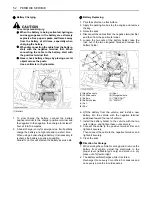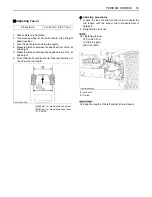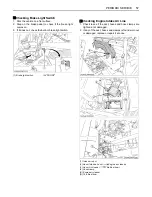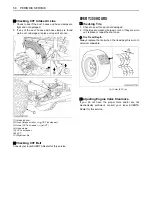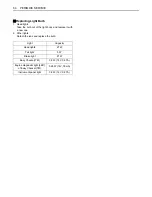
65
STORAGE
STORAGE
To avoid personal injury:
A
Do not clean the vehicle with engine running.
A
To avoid the danger of exhaust fume
poisoning, do not operate the engine in a
closed building without proper ventilation.
A
When storing, remove the key from the key
switch to avoid unauthorized persons from
operating the vehicle and getting injured.
VEHICLE STORAGE
If you intend to store your vehicle for an extended period
of time, follow the procedures outlined below.
These procedures will insure that the vehicle is ready to
operate with minimum preparation when it is removed
from storage.
1. Check the bolts and nuts for looseness, and tighten if
necessary.
2. Apply grease to vehicle areas where bare metal will
rust also to pivot areas.
3. Unload from cargo bed.
4. Inflate the tires to a pressure a little higher than usual.
5. Change the engine oil and run the engine to circulate
oil throughout the engine block and internal moving
parts for about 5 minutes.
6. With all implements lowered to the ground, coat any
exposed hydraulic cylinder piston rods with grease (if
equipped).
7. Remove the battery from the vehicle. Store the battery
following the battery storage procedures.
(See "Checking Battery Condition" in "EVERY 100
HOURS" in "PERIODIC SERVICE" section.)
8. Keep the vehicle in a dry place where the vehicle is
sheltered from the elements. Cover the vehicle.
9. Store the vehicle indoors in a dry area that is protected
from sunlight and excessive heat. If the vehicle must
be stored outdoors, cover it with a waterproof
tarpaulin.
Put boards under the tires to keep dampness away
from tire.
Keep the tires out of direct sunlight and extreme heat.
A
When washing the vehicle, be sure to stop the engine.
Allow sufficient time for the engine to cool before
washing.
A
Do not wash with a high-pressure car-washing
machine.
A
Cover the vehicle after the muffler and the engine have
cooled down.
REMOVING THE VEHICLE FROM
STORAGE
1. Check the tire air pressure and inflate the tires if they
are low.
2. Install the battery. Before installing the battery, be sure
it is fully charged.
3. Check all fluid levels (engine oil, transmission oil and
any attached implements).
4. Check the spark plug gap. Install and tighten plugs to
the specified torque.
5. Start the engine. Observe all gauges. If all gauges are
functioning properly and reading normal, move the
vehicle outside. Once outside, park the vehicle and let
the engine idle for at least 5 minutes. Shut the engine
off and walk around vehicle and make a visual
inspection looking for evidence of oil or water leaks.
6. With the engine fully warmed up, release the parking
brake and test the brakes for proper adjustment as you
move forward. Adjust the brakes as necessary.
Содержание RTV400
Страница 1: ...1AYAACPAP0010 READ AND SAVE THIS MANUAL OPERATOR S MANUAL UTILITY VEHICLE R T V 4 0 0 C i...
Страница 14: ...5 SAFE OPERATION 7 DANGER WARNING AND CAUTION LABELS...
Страница 15: ...SAFE OPERATION 6...
Страница 16: ...7 SAFE OPERATION...
Страница 17: ...SAFE OPERATION 8...
Страница 19: ......
Страница 91: ...R T V 4 0 0 C i English U S A Code No K7211 7121 1 PRINTED IN U S A KUBOTA Corporation 2011...


